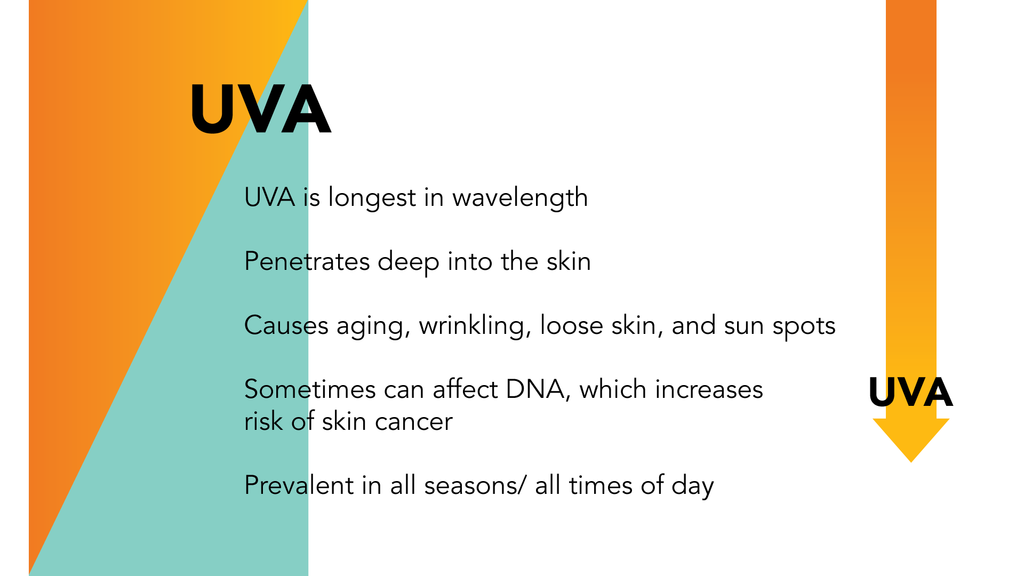UVA vs. UVB Radiation - What You Need to Know
UV radiation isn't always bad. In small doses, it actually helps us to produce vitamin D that our bodies need. The problem occurs when UV rays frequently come in contact with our skin; its effects can be long term and detrimental. These effects show up over time when our skin is not protected. Here's exactly what you need to know about UV radiation, how it affects us, and how to keep your skin safe!
UV rays are broken down into 3 different bands: UVA, UVB, and UVC. UV wavelengths vary in size and differ in how they affect our skin.
UVC is the shortest and not long enough to reach our skin; UVB rays come in contact with the outer layer of the skin; UVA radiation penetrates deeper into the skin, all the way into the inner layers.


Here's the breakdown:
1. UVC Radiation
UVC rays are actually the strongest but are mostly absorbed by the atmospheric ozone. They usually aren't destructive on our skin.
2. UVB Radiation
UVB rays reach past the ozone layer to the superficial layers of our skin. It is the most prevalent cause of the redness, sun burning, and skin cancer. These rays can cause changes in DNA in cells directly and be one of the top culprits to skin cancer.
The most important times to stay protected are during the spring and summer months between the hours of 10 am and 4 pm.

3. UVA Radiation
UVA rays permeate into the skin the deepest of the 3 different rays. They reach deep into the skin and are the predominant cause of aging, wrinkling, loose skin, and sunspots. They are not the number one culprit but can cause changes in DNA, which eventually can lead to skin cancer.
UVA rays are present all year round and in all seasons. They are able to bounce off reflective surfaces such as water, including liquid and ice or snow. It is vital to make sure that your skin is protected whether it be summer or winter, day or even night.

Here are a few tips to staying protected:
1. Choose a UPF 50 hat or clothing to keep your skin safe and protected from harmful UV rays. Use sunscreen for the hottest parts of the day (10 am - 4 pm.)
2. Remember to be cautious even during the winter months for UVA rays and stay protected when skiing or snowboarding. (UVA rays can reflect off snow or ice.)
For more tips, visit our UV index page to better understand the UV index chart and the meaning behind the different sun exposure ratings.
Always remember,
Block out the sun, not the fun!










can you please help me I cant find anything about the ozone layer and it makes me very very sad :( please help me PLEASE
Hi Cynthia,
Thanks for the message. You have every right to be concerned with sun exposure, and you’re definitely on the right track. We believe sun protective hats are also another good idea. You might also want to consider buying sun-neck protectors that are UPF 50+. We sell products like Kalahari, sun gaiters, and sun neck protectors that we believe are a good addition to the UPF 50+ shirts.
Hope this helps.
Team Sungrubbies
Hello Sharon,
I have a son who does roofing in San Antonio,Tx . I am extremely worried for His exposure to the sun ☀️ daily…he is in the sun ☀️ 8 or more hours a day… with no real protection as he is a new employee… Anfter my visit with him I sent Him UVB & UVB shirts…and goggles…what else can I send him…??? Are there Vitimins I can send Him.. Thank You In Advance for you Help…😎😊😎
Many authorities advise getting getting a certain measured, moderate amount of directs sunlight, usually on arms, legs, and face in order to keep Vitamin D at healthy levels. I fear that even that moderate amount of sunlight would also have the unwanted effect of further photoaging my skin. I currently try to resolve this dilemma by wearing shorts and thereby getting some sunlight on my lower legs during the summer, but wearing protective clothing on all other areas of my body, including arms, hands, neck, face, and head. Am I correct about the dangers of photoaging from even moderate amounts of sunlight? Is exposing just my legs during the summer sufficient to keep Vitamin D levels healthy?
Leave a comment